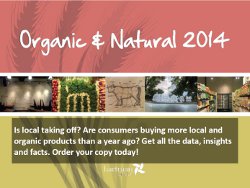As organic’s authenticity halo fades, consumers turn to local food
As organic’s authenticity halo fades, consumers turn to local food
2014-09-16
What’s better than organic?
To hear Organic Valley tell it, milk from grass-fed cows might be preferable in the dairy case. The cooperative says its Grassmilk product is flying off shelves at Whole Foods – a glittering star among stars. Many shoppers “have almost an intuitive sense that grass is better,” Organic Valley’s CEO told The New York Times.
But Whole Foods’ high-end aura and butt-of-joke prices make grass-fed milk a rarefied example. Many retailers do not even sell it.
If you’re looking for the next organic on a broad scale, better to look toward local.
The authenticity halo around organic and natural has begun to fade, and local foods and beverages are poised to surpass them as a symbol of trust and transparency, The Hartman Group found in its new report, “Organic & Natural 2014.”
“No longer merely a bridge between organic and natural, local now speaks to consumer desires for a food system with integrity,” according to the report.
With its connotations of community, economy and environmental stewardship, local offers compelling narratives that include small-scale production and closer, reciprocal relationships with food producers.
Although local products carry prices that put them out of reach for many people, consumers in all segments are turning toward local to help them resolve their confusion and uncertainty surrounding organic certifications and the claims of the organic marketplace.
People believe in the integrity of local producers and small farmers, seeing them as deeply invested in the quality of their products. Their trust is bolstered by the close proximity of local food sources, which translates into shorter distances traveled – and thus a perception of greater freshness. They like keeping their money in the community and the idea that they are eating food that’s in season.
“Local is more important to me than organic,” one Nashville resident told The Hartman Group. “It’s about building a relationship. Asking local farmers about their practices is better than what the government can tell me.”
That faith in a personal – or at least closer – relationship with the people growing their food contrasts with an organic industry that has grown so big, its products are both easier to find and easier to doubt. A whopping 73 percent of consumers now buy organics, and more than a third use them at least monthly.
But consumers question the ability of big companies to do organic “right.”
Part of their concern comes from seeing highly processed foods that some consider “junk food” bearing the organic label; they wonder whether these companies share their values or are diluting the spirit of organics. They also worry that corporate interests are weakening U.S. Department of Agriculture standards and wonder whether the USDA has the resources to verify and enforce certification in such a rapidly expanding arena.
Half of consumers are aware that there are governmental standards regulating the use of the organic label on foods and beverages. Of those people, a growing share – now at 49 percent – trust the label “not at all,” “very little” or “somewhat.”
Some consumers turn to other certification sources, such as Oregon Tilth. Although consumers no longer imbue organics with the same glowing beliefs about authenticity that they used to, people continue to want them for a host of concrete reasons – notably, for what they lack: pesticides, herbicides, growth hormones, antibiotics, artificial flavors, artificial colors, preservatives and GMOs.
Shoppers spend the most money on organic produce, meat and dairy – and 63 percent complain that prices are too high, although falling price points are accelerating the adoption of organic packaged foods.
In the big picture, they want to support companies that share their values and are committed to organic, natural and real food – but they do not easily trust companies to sincerely embrace those values.
Farmers markets come close. Supermarkets try, hanging photos of the farmers who grow their produce. But the designation that is gaining the most traction and sometimes trumping even organic itself is local.
For more or to order: Organic & Natural 2014

